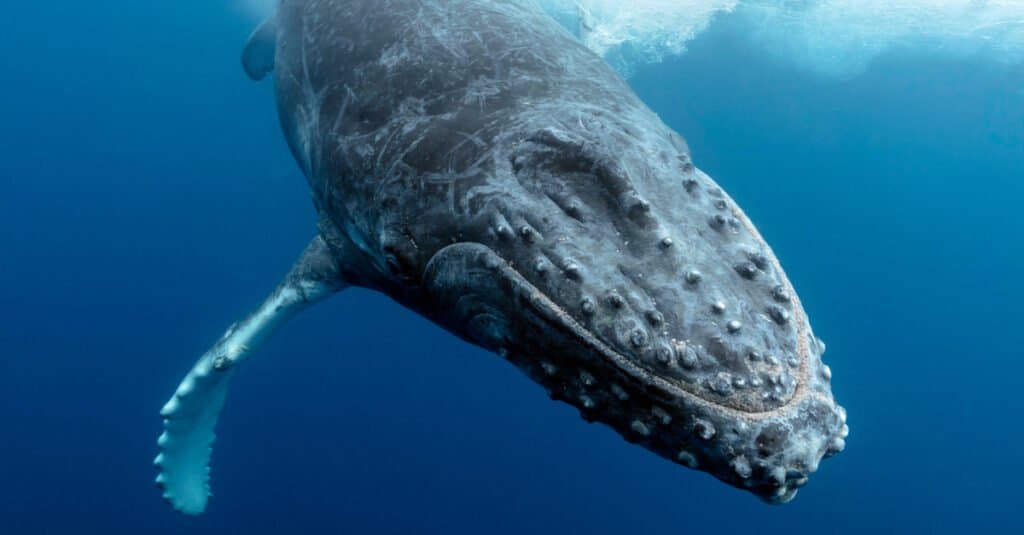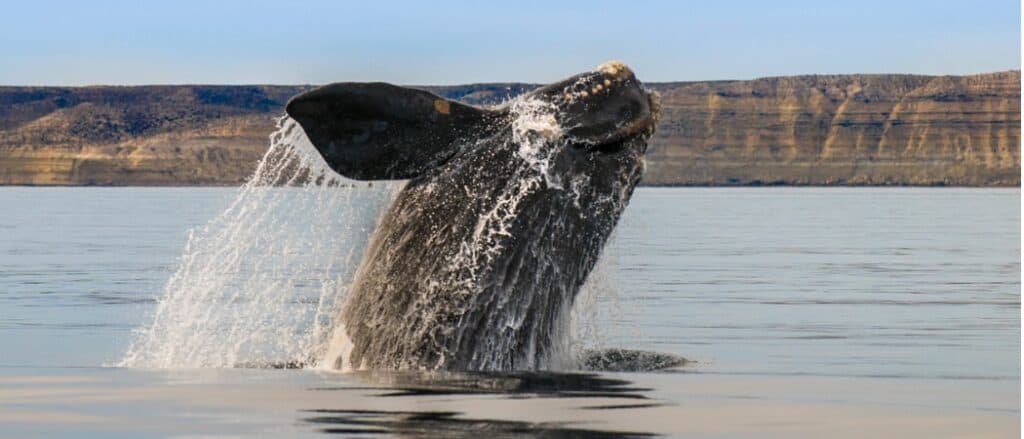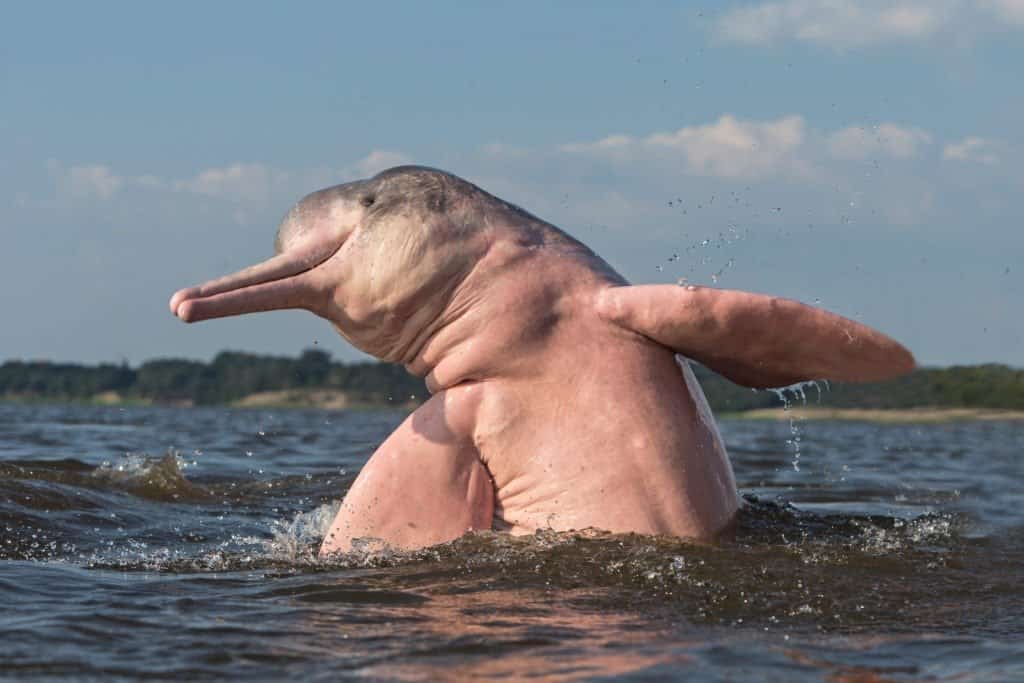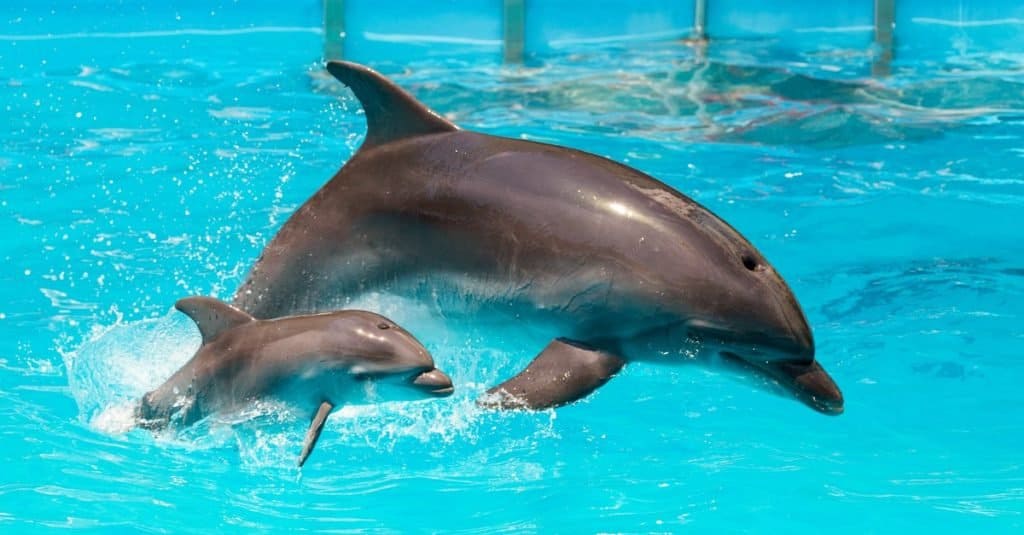Can you imagine an enormous blue whale covered in long flowing gray hair? That seems to be a stretch of the imagination! When we think of whales or dolphins we think of smooth, hairless skin that makes it easy for these marine animals to glide through the ocean. Yet, mammals are animals that have hair and whales are mammals. So, do whales have hair?
Specifically, mammals are animals that meet the following criteria:
- Breath air (not using gills)
- Warm blooded
- Give birth to live young
- Babies drink their mother’s milk
- Have hair
Check, check, check, check, but what about the fifth? How can whales and dolphins be considered mammals if they don’t have hair…or do they?
4 types of whale that have hair
Whale species do have hair, even though they might not be covered in it. Let’s look at four types of whale and the hair they have on their body!
1. Humpback whales

A
Humpback whale
breaching in “Marino Ballena National Park”, Costa Rica. Humpback whales have some of the longest migrations of any mammal with some populations swimming 5,000 miles (8,047 km) between breeding and feeding grounds.
©Claude Huot/Shutterstock.com
These large whales are baleen whales that sieve the water for tiny krill. They can consume up to 3,000 lbs of food a day to keep their 40-50 foot bodies going. Humpback whales are named for the hump on their…yes, you guessed it…back. Not like a camel hump, but they do have a hump right before their dorsal fin. They also have long fins on either side of their bodies and grooves on their underside.
Their face appears for be covered in barnacles, but upon closer inspection you will find that these are giant golfball-sized hair follicles. Hair follicles? Yes, humpback whales have hair, but with each follicle carrying one single hair, you can easily count the number of hairs on a humpback’s head. They usually have anywhere from 30-100 hairs, that’s it! These hairs are visible throughout the whale’s lives.

The bumps on humpback whale’s face are actually hair follicles!
©Craig Lambert Photography/Shutterstock.com
2. Fin whales, Sei whales, Right whales, and Bowhead whales

southern right whale coming out of water
©Foto 4440/Shutterstock.com
This group of baleen whales has very small hair-like whiskers on their muzzle, chin and jaw line. These whiskers have nerves that are connected to the roots and are thought to serve a sensory purpose. These are not easy to see and some do not have them at all. What confuses people is that some of these baleen whales appear to have an elaborate mustache! When you look at pictures of these great whales you can understand why. But these are actually their baleen, not hairs of a mustache. The baleen are long hair-like structures that filter the water, only allowing the small krill, plankton and tiny fish to get through.
3. Amazon River Dolphin

An
Amazon river dolphin
, often known as the pink dolphin!
©COULANGES/Shutterstock.com
Dolphins are a kind of whale; they are toothed whales that include a variety of salt and freshwater dolphins. The Amazon River dolphin is a freshwater dolphin that lives in the Amazon River as well as the Orinoco River. These unique dolphins look like a bottlenose dolphin except for their pink-tinted skin and a Pinocchio-like snout. Another feature lacking in the bottlenose is hair! Amazon River dolphins have hair that is on their snout, almost like the whiskers on a kitten or walrus. It is believed they use them as a sensory tool to help locate prey in the murky river water. They are born with these and keep them into adulthood.
4. Baby Dolphins

A charming
dolphin baby
swims with his mom in a pool. They are not only the friendliest or caring creatures but also the most intelligent ones.
©Elena Larina/Shutterstock.com
Some dolphins have hair in the womb as fetuses and lose it before they are born whereas other dolphins are born with hair and lose it soon after birth. We are not talking about little fuzz balls, they only have sparse hair or whiskers usually found on their snout. It is believed that these early whiskers may be used to rub up against the mother letting her know that her calf is ready to eat. Once the calf no longer needs this they lose the whiskers and do not regrow any hair as an adult.
Top 5 Reasons Why Whales and Dolphins Might have Hair
Whales and dolphins might have hair for a variety of reasons. Here are five of the top reasons whales have hair:
- Left-over from when their ancestors were land mammals: It is thought that whales and dolphins are related to mammals that once roamed the land. If they were land dwelling animals they may have had elaborate coats of fur for protection and to provide warmth.
- Sensing prey in the water: The whisker-type hairs on the Amazon River dolphin are used to find prey in the murky waters of the river. Amazon River dolphins also use echolocation, so these two tools may work together to be even more accurate in locating food.
- Determining how many prey are in the area: For baleen whales, it is thought that they may use the whisker-like hairs on their faces to sense if there are enough prey in an area to put forth the effort to open their mouths and expose their baleen to sieve for food.
- Sensing temperature change in the water: The whisker-like hairs on whales may serve to sense changes in water temperature which may alert them to changes in the currents during migration, helping them decide which way to go.
- Communicating with each other or between mother and baby: Dolphins that are born with whisker-like hairs may rub their whiskers along their mothers, communicating that they want to nurse. This is one theory why they lose their hairs when they are able to eat all on their own.
Do any other marine mammals have hair?
Yes! Remember that one of the characteristics of mammals is that they have hair. But what other animals that spend most of their time in water also have hair?
- Harp Seals: Think of a cute little fuzzy harp seal baby. These babies are born covered in thick white fur. They need this to keep them warm in the harsh winter climate. Whales on the other hand have a thick layer of blubber to help them maintain their temperature.
- Sea Otters: They look like beavers but are much, much bigger! Sea otters can get to be 4 feet long and weigh around 90lbs. They spend most of their time in the water, searching for food and floating on their backs in groups called “rafts”. They have the thickest fur of all animals with over 900 million hairs! Compare that to the 30-100 hairs of the humpback whale. What a difference!
- Northern fur seals: Northern fur seals live in the cold oceans of the North Pacific and Bering Sea, spending around 300 days/year at sea. They are the largest members of the fur seal family, Pinnipeds, weighing 130-600lbs and reaching lengths between 5-7 feet long. Northern fur seals have a heavy coat of dense fur having 300,000 hairs per square inch. Their fur is a dark brown color which helps hold in heat. Northern fur seals do not have blubber like whales; their thick coat of fur is their primary heat conservation tool.
The photo featured at the top of this post is © Craig Lambert Photography/Shutterstock.com
Thank you for reading! Have some feedback for us? Contact the AZ Animals editorial team.






